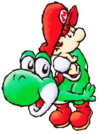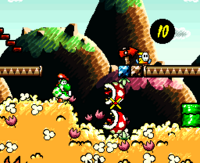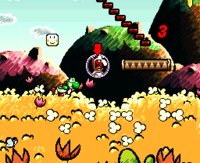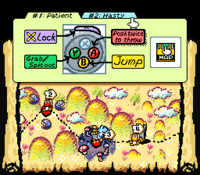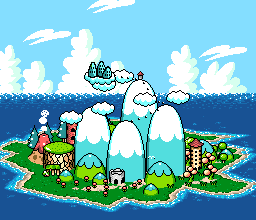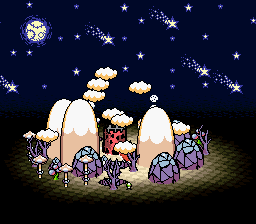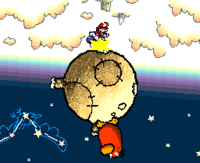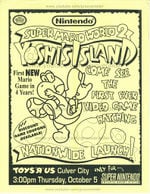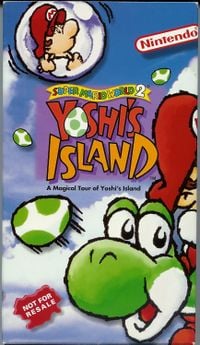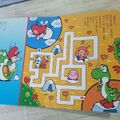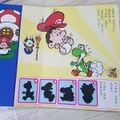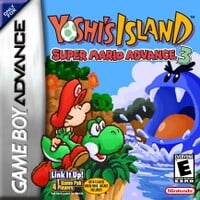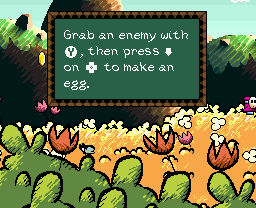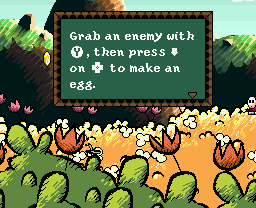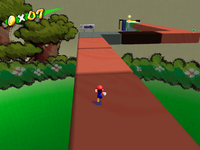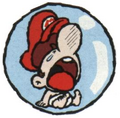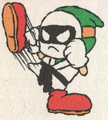Super Mario World 2: Yoshi's Island: Difference between revisions
m (Text replacement - "{{[Mm]ain-external\|" to "{{main-wiki|") |
m (Text replacement - "(\| *|{{)[Mm]edia( *=|\|)" to "$1format$2") |
||
| Line 13: | Line 13: | ||
|ratings={{ratings|esrb=K-A|acb=G}} | |ratings={{ratings|esrb=K-A|acb=G}} | ||
|platforms=Super Famicom / [[Super Nintendo Entertainment System]], [[Classics#Super NES Classic Edition|Super NES Classic Edition / Super Famicom Mini]], [[Super Nintendo Entertainment System - Nintendo Switch Online]] | |platforms=Super Famicom / [[Super Nintendo Entertainment System]], [[Classics#Super NES Classic Edition|Super NES Classic Edition / Super Famicom Mini]], [[Super Nintendo Entertainment System - Nintendo Switch Online]] | ||
| | |format={{format|snes=1|snesclassic=1|switchdl=1}} | ||
|input={{input|snes=1|snesclassic=1|joy-con=1|switchpro=1|switchsnes=1}} | |input={{input|snes=1|snesclassic=1|joy-con=1|switchpro=1|switchsnes=1}} | ||
}} | }} | ||
Revision as of 15:43, June 5, 2024
- "YI" redirects here. For the Game Boy Advance version, see Yoshi's Island: Super Mario Advance 3.
- "SMW2" redirects here. For the game known as "Super Mario Wii 2" in South Korea, see Super Mario Galaxy 2.
| Super Mario World 2: Yoshi's Island | |||||
|---|---|---|---|---|---|
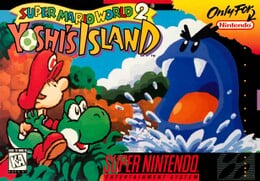 For alternate box art, see the game's gallery. | |||||
| Developer | Nintendo EAD | ||||
| Publisher | Nintendo | ||||
| Platform(s) | Super Famicom / Super Nintendo Entertainment System, Super NES Classic Edition / Super Famicom Mini, Super Nintendo Entertainment System - Nintendo Switch Online | ||||
| Release date | Super Nintendo Entertainment System: Template:Release Super NES Classic Edition: Template:Release Super Nintendo Entertainment System - Nintendo Switch Online: Template:Release[?] | ||||
| Language(s) | English (United States) French (France) German Japanese | ||||
| Genre | Platform | ||||
| Rating(s) |
| ||||
| Mode(s) | Single-player Multiplayer Mini Battles | ||||
| Format | Super NES: Nintendo Switch: Super NES Classic Edition:
Built-in
| ||||
| Input | Super NES: Nintendo Switch: Super NES Classic Edition:
| ||||
Super Mario World 2: Yoshi's Island (frequently referred to simply as Yoshi's Island) is a 2D platform game for the Super Nintendo Entertainment System, developed by Nintendo EAD. The game is the prequel to Super Mario World and it stars Yoshi and the Yoshi clan who, while carrying baby Mario, travel across Yoshi's Island to rescue baby Luigi from baby Bowser and his Magikoopa minion/caretaker, Kamek. Instead of relying on jumping and a power-up system for combat as in the traditional Super Mario platformers, Yoshis use their tongue and eggs to overcome obstacles, as well as the introduction of many other different mechanics. The game is notable for introducing a time-based health system rather than hit points, an anomaly to what many platform games typically did in this game's time period. Rather than relying on powerful pre-rendered graphics just like its contemporary Donkey Kong Country, Super Mario World 2: Yoshi's Island employs a very distinct, stylized arts and crafts style to stand on its own. The game makes use of the Super FX2 graphics chip (one of only four commercially-released SNES games to do so), which allows for larger, more detailed sprites and more advanced effects that emulate 3D space.
Although Super Mario World 2: Yoshi's Island was not as financially successful as its predecessor, the game's highly positive reception and unique style has spawned a new series of platform games from the Yoshi franchise, although it is the fourth entry overall. The game has received various adaptations into manga, such as receiving volumes dedicated to it in the Super Mario-kun and Kodansha's Super Mario manga series and extensive merchandising. This is the only Yoshi's Island game to be released on a home console. The game has received a remake on the Game Boy Advance, Yoshi's Island: Super Mario Advance 3, which was released on Virtual Console for the Nintendo 3DS (with owners applicable for the Nintendo 3DS Ambassador Program being able to download the game for free) and Wii U. The original SNES version of Super Mario World 2: Yoshi's Island is included on the SNES Classic Edition, and although it was never announced for release on Virtual Console on any other system, it is one of the 20 launch titles for Super Nintendo Entertainment System - Nintendo Switch Online on the Nintendo Switch. A sequel, Yoshi's Island DS, was released in 2006 for the Nintendo DS. In 2014, the Nintendo 3DS game Yoshi's New Island continues the story told from the first game.
Story
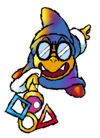
From the first cinematic of Super Mario World 2: Yoshi's Island:
Narrator: A long, long time ago... This is a story about baby Mario and Yoshi. A stork hurries across the dusky, pre-dawn sky. In his bill, he supports a pair of twins. Suddenly, a shadow appears in a gap between the clouds and races towards the stork with blinding speed.
Kamek: "SCRREEEECH!!!"
Kamek: "THE BABIES ARE MINE!"
Narrator: WOW!!! Snatching only one baby, the creature vanishes into the darkness from whence it came. The second baby falls undetected towards the open sea... OH NO...
Meanwhile, here is Yoshi's Island, home to all Yoshies. It's a lovely day, and Yoshi is taking a walk. HUH?!? Suddenly, a baby drops in onto his back. The baby seems to be fine. This is very fortunate! Wha-? Something else fell with the baby... Let's take a peek... It looks like a map. Maybe the stork was using it? But Yoshi can't figure it out. Yoshi decides to talk to his friends.
Kamek: AAAAAAAAAAKK!!!
Narrator: Kamek, the evil Magikoopa, and kidnapper of the baby, quickly dispatches his toadies, when he discovers that he missed the other baby!
Yoshi heads leisurely back to the other Yoshies, unaware of the danger at hand. Kamek's forces are actively searching the island. Will these two children ever reach their parents safely?
From the second cinematic of Super Mario World 2: Yoshi's Island:
Narrator: This paradise is Yoshi's Island, where all the Yoshies live. They are all in an uproar over the baby that fell from the sky. Wait! The baby seems to know where he wants to go... The bond between the twins informs each of them where the other one is. The Yoshies decide to carry the baby to his destination via a relay system. Now begins a new adventure for the Yoshies and baby Mario.
From the instruction booklet:
This story happened a long time ago...this is a story about a baby and Yoshi...
A stork hurries across the dusky, pre-dawn sky. In his bill, he supports a pair of twins, who are to be delivered to their parents as soon as possible.
Suddenly, something appears between the clouds and races towards the stork with blinding speed!
"SSCCRREEEEECH!!!", it screams. "These babies are mine!"
Snatching only one baby, the creature vanishes into the darkness from whence it came.
Oh no! The second baby falls undetected towards the open sea...
The kidnapper is Kamek, an evil Magikoopa from the Koopa Kingdom. Having divined last night that twin babies born this morning will bring disaster to the Koopa family, he arranged for an early morning ambush. Returning to his castle, Kamek realizes that he missed the other baby. He orders his toadies.
"Go forth and find that other baby! Don't let his parents get him back! Ever!!"
Meanwhile, the second baby does not fall into the sea after all...it lands safely on Yoshi's back! And right after him drops a map!!
This paradise is Yoshi's Island. And on this island lives lots of different Yoshies. These Yoshies are naturally laid back and relaxed, but this a calamity and everyone is in a state of panic. As the Yoshies frantically yell over each other, the baby insistently points at something.
Yes! The baby can sense the other baby's location. All the Yoshies quickly agree to help carry the baby to its destination by using a relay system not unlike the old pony express.
The Green Yoshi draws first honors.
The story of Super Mario World 2: Yoshi's Island takes place while Mario and Luigi are in their infancy, referred to as baby Mario and baby Luigi respectively. A stork was about to deliver the newborn twins baby Mario and baby Luigi to their parents, but is ambushed by Kamek on the way there. While Kamek was successful at capturing baby Luigi and the stork and imprisons them at Bowser's Castle, baby Mario plummets into the sea, only to find himself on a Yoshi's back on an island. The Yoshis then discover that baby Mario also has a map with him, which reveals the location of Bowser's Castle. Kamek has then figured out that he has missed baby Mario and then has dispatched his Toadies to kidnap baby Mario. While the Yoshis discuss what to do with baby Mario, baby Mario then notifies the Yoshis which direction to go due to a powerful twin link, where the Yoshis then employ a relay system to transport baby Mario across the island. After overcoming obstacles and fighting bosses that Kamek has enlarged in various forts and castles in the island, the Yoshis finally manage to defeat Kamek and baby Bowser and rescue baby Luigi and the stork, allowing the stork to safely deliver the babies to their parents.
Gameplay
Like the early titles of the Super Mario series, Super Mario World 2: Yoshi's Island is a two-dimensional, side-scrolling platform game. In addition to the typical run and jump controls, the Yoshis can also ingest enemies and manipulate objects using their tongue. After ingesting an enemy, the Yoshi can either eject or swallow them, although if Yoshi keeps an enemy in his mouth long enough, he will eventually swallow it (with the exception of enemies he can only ingest and spit out, and not fully swallow). Swallowing most enemies allows the Yoshi to lay a Yoshi Egg, which it can carry up to six of; eating another enemy results in the egg at the front of the line to be discarded. While Yoshi has some eggs, the player can aim with a constantly moving target reticle and throw them to damage enemies, activate objects, ricochet them off solid surfaces, and skim them across water. This reticle can be locked into one position while aiming, and while Yoshis are aiming their eggs, they can still move around and jump. While most eggs come in green, some are yellow and red, and they release coins and stars when shattered respectively. While a Yoshi throws an egg, the egg changes color depending on how much it has bounced off walls. Green eggs can bounce up to three times, yellow eggs bounce only twice, and red eggs bounce only once. Power-ups also exist in the form of metamorphosis bubbles, which allow Yoshi to transform into various forms, and the Super Star, which lets baby Mario turn into Powerful Mario. In addition to these moves, Yoshis can use Hovering Jumps multiple times in the air to increase the distance they travel. The first Hovering Jumps can increase the height of the jump, but subsequent Hovering Jumps mostly serve to prolong the duration of the fall. Yoshis can Pound The Ground to smash stakes and defeat certain types of enemies. Camera controls include looking up to see upper areas of the level and ducking to force the camera down.
Super Mario World 2: Yoshi's Island introduces the concept of time-based health, a mechanic that is reused in future Yoshi's Island games. When the Yoshi comes into contact with an enemy, baby Mario becomes separated from Yoshi, encased in a bubble and floating around in the air. While baby Mario is in this state, a Countdown Timer appears, counting down in seconds until it reaches zero, in which time Yoshi must recover baby Mario or Kamek's Toadies take baby Mario, and the player loses a life. The Timer starts at ten seconds at the beginning of each level, and can be increased to a maximum of thirty by collecting Stars, using 10 Point Stars and 20 Point Stars, and entering Middle Rings. If the Timer falls below ten, it increases back up to ten slowly after recovering baby Mario. Entering a Middle Ring also marks the point where the Yoshi can continue from if it loses a life. Other ways Yoshis can lose lives are if they touch spikes or thorns, if they fall off a cliff, if they touch lava, if they get eaten by a Lunge Fish, or if they get crushed by moving platforms. In these cases, Yoshi's death is shown onscreen, either by spinning and collapsing or flying offscreen. If the player runs out of lives, they receive a Game Over.
There are six worlds in this game, and each world has nine levels total. The objective of each level is to reach the Goal Ring roulette. There are ten spots on the roulette, and five of the spots can be made winning spots by collecting the five Special Flowers in each level. Landing on one of the flower points allows the player to play a Bonus Challenge. These Bonus Challenge allow Yoshis to either gain lives or Special Items for use in levels. Two levels in each world are forts and castles, and the goal in those levels is to reach and defeat the eponymous boss that resides in those establishments rather than reach a Goal Ring. Most bosses are regular enemies that are enlarged by Kamek prior to the fight, with a few exceptions.
Scattered throughout each level are three types of collectibles: thirty Stars, twenty red coins, and five Special Flowers. At the end of each level, the player's score is tallied with a maximum of 100 points, with flowers worth ten points each and red coins and Stars one point each. Attaining a perfect one hundred points in all eight levels in a world unlocks a Bonus Challenge and an "extra" ("special" in Japanese) level on the level selection map. The extra levels are designed to be more difficult than any other level in the game, and each one has its own unique gimmick. However, the player can always choose to exit an extra level by pausing the game and pressing ; in other levels, this can be done only if the level in question has already been cleared.
If the player succeeds in attaining a perfect one hundred points in the extra level of a world, a Star is added to the top of the title screen the next time the player turns on the game, for a maximum of six Stars.
Controls
There are two controller configurations: Patient and Hasty. By default, Patient is selected. The control setup can be swapped at any time on the world map by scrolling over to the button with the Super Nintendo controller next to the "Score" option and selecting it; additionally, at some points, there are Message Blocks that allow the player to swap control configurations. The only difference between the "Hasty" and "Patient" settings is that with "Patient" the player must press to target and press it again to throw an egg, while with "Hasty" the player must hold
to target and release it to toss an egg.
| Action | Patient | Hasty |
|---|---|---|
| Move | ||
| Jump | ||
| Pound The Ground | ||
| Eat, spit out | ||
| Duck, swallow | ||
| Aim/throw egg | ||
| Lock target reticule | ||
| Look up | ||
| Pause menu | ||
| Level options | ||
Worlds and levels
The setting of the game takes place on Yoshi's Island, which is the first world setting of Super Mario World. The island portrayed in Super Mario World 2: Yoshi's Island, however, is much larger in scale and comes with a larger variety of biomes and characters endemic to the island as players progress through the game. The game contains six worlds with eight regular levels each, retaining the eight level per world structure first normalized by Super Mario Bros. 3, having a consistent amount of levels per world, and every fourth and eighth level of the world features a boss fight against an enemy enlarged by Kamek. All worlds have particular themed biomes, such as World 1 having a grasslands while World 6 has a stronger theme around caverns and lava as the player closer approaches King Bowser's Castle; this theming of levels has been carried in further entries of the Yoshi's Island series. Unlike Super Mario World, Super Mario World 2: Yoshi's Island does not employ use of a world map and relies on a level select screen, which is represented by color-coded folders containing icons that preview the levels, and these levels are named after their features than rather than using generic numbered identifies, such as the third level of World 3 being called Nep-Enut's Domain rather simply being called World 3-3. One notable aspect of the level icons is that all Yoshis in their previews are Green Yoshis, despite Green Yoshis being used only in the first levels of each world, the Extra levels and King Bowser's Castle. While most levels have players moving on their own accord, a few levels are autoscrollers, with the first one being encountered in Hop! Hop! Donut Lifts in World 1.
Every world contains an unlockable level known as an Extra levels, which are unlocked when players get a 100 score in all levels of the worlds. These levels feature a gimmick and are shorter and more difficult than other levels of the game, often do not contain Middle Rings and they are optional to complete in regards of general progression of the game. These levels do not feature unique icons that display a preview of the level and are instead represented by a star with a number and identifier. In addition, when players first play the game, they play through a level called Welcome To Yoshi's Island, which serves as a short tutorial guiding players basic controls of the game. Once completed, it cannot be replayed, effectively making it an unrevisitable area.
Due to the light arts and crafts aesthetic of the game and usage of the Super FX2 graphics chip, levels and their backdrops are rendered reminiscent of drawings rather than the more organic approach that Super Mario World has done, and their backdrops are dynamically rendered with a more complex palette. For example, the primary backdrop for Watch Out Below! from World 1 uses a soft palette and hills having an emulated colored pencils aesthetic, clouds and hills contain visible shading streaks to communicate their shadows, environment features such as waterfalls and crystals in cave levels such as The Cave Of Chomp Rock and The Cave Of The Mystery Maze are animated, Goonie Rides! renders a shimmering ocean with a large flock of the Goonie species and variants flying in the background, while the general aesthetic of World 6 primarily uses warm color palettes to communicate players that the world is lava-themed and the final world of the game.
Characters
Playable characters
The Yoshi species are the primary playable characters of the game and this appearance is their first starring appearance in a platformer title. All Yoshis play identically to each other, and Super Mario World 2: Yoshi's Island introduces even more color variations to the Yoshi species: in addition to the Green, Red, Blue and Yellow Yoshis that are present in Super Mario World, Pink, Light Blue, Purple, and Brown Yoshis are introduced. While Pink, Light Blue, and Purple Yoshis become mainstay colors in future installments of the overall Super Mario franchise, Brown Yoshis remain exclusive to this title, being replaced by Orange Yoshis. The Yoshis in this game retain their long tongues and their abilities to eat most objects from Super Mario World, though the game introduces Hovering Jumps, turning enemies and objects into eggs that can be used as projectiles, and pounding the ground.
The Yoshi colors are specific to the levels they are played on.
Template:Content appearances
a - The Yoshis' positions on the map screen are swapped, with the Pink Yoshi at the seventh level and the Red Yoshi at the second. This was corrected in the Game Boy Advance version.
Supporting characters
While Yoshi games prior feature adult Mario in a starring role while Yoshi accrues a more passive role, such as Yoshi, Yoshi's Cookie, and Yoshi's Safari, Super Mario World 2: Yoshi's Island and further entries in the Yoshi's Island series flips the roles in which the Yoshis are the primary, controllable stars while Mario, as baby Mario, rides on Yoshis and acts as their timed health meter should they get hurt by enemies or objects. Baby Mario is directly controllable only under the effects of the Super Star as Superstar Mario where he dons a yellow cape and becomes invincible. Luigi makes his debut in the overall Yoshi franchise as baby Luigi, though his role mirrors Princess Peach of the Super Mario franchise in that he is kidnapped and the overall goal of the game is to rescue him from Kamek and baby Bowser's clutches.
Two supporting characters are introduced in Super Mario World 2: Yoshi's Island and make recurring appearances throughout the Yoshi franchise. The stork, designed after the white stork representing an animal of folklore known to deliver babies to parents, gets ambushed and kidnapped alongside baby Luigi at the start of the game. The latter character Poochy is a dog-like creature that follows Yoshi around and Yoshi can ride on who can run on dangerous terrain such as lava and spikes.
| Image | Name | Description
|
|---|---|---|
| Baby Mario | Mario as an infant. The Yoshis have to transport him and take care of him throughout the game. Players can control him when he obtains a Super Star. | |
| Baby Luigi | Luigi as an infant. He is kidnapped by Kamek and, similar to Princess Peach of the Super Mario franchise, he needs to be rescued. | |
| Stork | The bird that delivers baby Mario and baby Luigi to their parents. The stork is captured by Kamek, alongside baby Luigi. |
Helpers
Six helpful, generic characters assist Yoshis should they meet them. They are all harmless characters and help Yoshis either navigate through the course or provide Yoshis with ammunition such as Melon Bugs and Huffin Puffins. Template:Content appearances
Enemies
Bosses
Each world features a midway fort (the fourth level) and an end-world castle (the eighth level) with a mid-boss and a big boss respectively. Every boss is just an enlarged version of a basic enemy that Kamek super-sizes with his magic. The only exception is Froggy, who remains at his normal size while Yoshi and baby Mario are shrunk; he then eats them and the battle is located in his stomach.
Mid-bosses
| Image | Name | Description
|
|---|---|---|
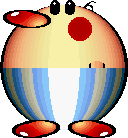 |
Burt the Bashful | Burt the Bashful is the mid-boss of World 1, fought at the end of Burt The Bashful's Fort. He is an enlarged Burt that Yellow Yoshi must defeat by throwing eggs at him. Burt attacks Yellow Yoshi by bouncing around. Whenever Burt is hurt, his pants lower; he is defeated when his pants are gone entirely. It takes six hits to defeat him. |
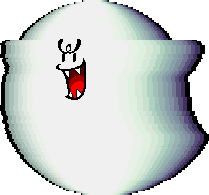 |
Bigger Boo | Bigger Boo is the mid-boss of World 2, fought at the end of Bigger Boo's Fort. He is an enlarged Big Boo that chases around Yellow Yoshi when Yellow Yoshi is turned away. When Yellow Yoshi looks at Bigger Boo, he turns invisible and therefore, cannot be hit. To defeat Bigger Boo, Yellow Yoshi must ricochet eggs off walls so that it hits him while he is following Yellow Yoshi as Yellow Yoshi looks away. Every time Bigger Boo is hit, he grows in size; hitting him five times defeats him. |
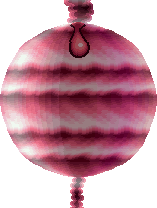 |
Froggy | Froggy is the mid-boss of World 3, fought at the end of Prince Froggy's Fort. He is a normal Frog Pirate that eats Yellow Yoshi when he is shrunk by Kamek. The battle takes place in Froggy's stomach, where Yellow Yoshi needs to hit the uvula at the top of the stomach with eggs. The main hazards in this battle are the gastric acid and the Shy-Guys (appearing big to Yoshi) Froggy eats. |
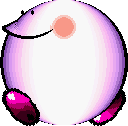 |
Marching Milde | Marching Milde is the mid-boss of World 4, fought at the end of Marching Milde's Fort. She is a large Milde who attacks by walking left and right, where she hurts Yellow Yoshi from the sides. To attack her, Yellow Yoshi needs to Pound The Ground below her from above, which causes her to split to two extra large Puchipuchi L. Yellow Yoshi needs to Pound The Ground on them again to turn them into common sized Puchipuchi L, and then again to turn them into regular Mildes. Once all Mildes are defeated, the boss battle is won. |
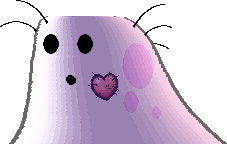 |
Sluggy the Unshaven | Sluggy the Unshaven is the mid-boss of World 5, fought at the end of Sluggy The Unshaven's Fort. He is an enlarged Sluggy whose weak point is a heart that Yellow Yoshi needs to attack in order to damage him. To reach his heart, Yellow Yoshi needs to throw eggs at his gelatinous skin, which exposes the heart with every hit. Sluggy does not damage Yellow Yoshi, but he can push Yellow Yoshi over a pit if he advances far enough. |
 |
Tap-Tap the Red Nose | Tap-Tap the Red Nose is the mid-boss of World 6, fought at the end of Tap-Tap The Red Nose's Fort. He is an invincible boss that attacks Yellow Yoshi by jumping onto the Yoshi. To defeat the boss, Yellow Yoshi needs to destroy the blocks on the floor to create a gap that leads to the lava and then push Tap-Tap the Red Nose into the lava by throwing eggs at him. |
Big bosses
| Image | Name | Description
|
|---|---|---|
 |
Salvo the Slime | Salvo the Slime is the big boss of World 1, fought at the end of Salvo The Slime's Castle. He is an enlarged Slime where Blue Yoshi must defeat him by throwing eggs at him. Whenever Salvo takes a hit, he reduces in size and releases Lemon Drops. Salvo additionally attacks by bouncing around, and the smaller he gets, the faster he moves around. He attempts to attack Yoshi by pushing him to the edge of the room, with lava as the obstacle. |
 |
Roger the Potted Ghost | Roger the Potted Ghost is the big boss of World 2, fought at the end of The Potted Ghost's Castle. He is a large ghost growing from a pot that is a stationary target. In order to defeat Roger, Blue Yoshi needs to push the pot he is stationed at off a cliff, where other Shy-Guys resist Blue Yoshi's efforts from the other side. Roger can also lunge and shoot fire at Blue Yoshi. |
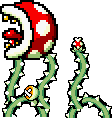 |
Naval Piranha | Naval Piranha is the big boss of World 3, fought at the end of Naval Piranha's Castle. It is an enlarged Wild Piranha that attacks Blue Yoshi with Nipper Spores and its two buds. Its weakness is the bandaged bump where Blue Yoshi can throw eggs at. Blue Yoshi can also defeat Naval Piranha in one hit before it even enlarges by throwing an egg at it before Blue Yoshi approaches the area. |
 |
Hookbill the Koopa | Hookbill the Koopa is the big boss of World 4, fought at the end of Hookbill The Koopa's Castle. He is an enlarged Koopa Troopa who attacks by lunging towards Blue Yoshi. Blue Yoshi needs to toss several eggs at Hookbill's head or arms to topple him over, where Blue Yoshi needs to Pound The Ground on his belly to damage him. After Hookbill has been damaged, he retreats into his shell and pounds the ground repeatedly. Once this attack is finished, he resumes his normal attack pattern. |
 |
Raphael the Raven | Raphael the Raven is the big boss of World 5, fought at the end of Raphael The Raven's Castle. He is an enlarged Raven where the battle takes place on the moon. Blue Yoshi needs to pound on stakes on the opposite side as Raphael in order to damage him. Raphael attacks by chasing Blue Yoshi, as well as Pounding The Ground to create shockwaves that circle the moon. Every time Raphael is hit, he obtains a faster attack pattern; three hits defeats him. |
| Baby Bowser | Baby Bowser is the big boss of World 6, fought at the end of King Bowser's Castle. He is one of the antagonists of the game and has two phases. The first phase involves baby Bowser in his normal form, where he tries to Pound The Ground on the Green Yoshi to ride on him. Green Yoshi can attack baby Bowser by Pounding The Ground, using the shockwaves as an attack. | |
  |
Big Baby Bowser | In the World 6 castle King Bowser's Castle, when Green Yoshi delivers three hits to Baby Bowser, Kamek enlarges baby Bowser, starting the second phase of the fight. In order to attack Big Baby Bowser, who approaches from the background, Green Yoshi needs to obtain Giant Eggs from Baron von Zeppelins that occasionally fly in. Big Baby Bowser attacks by sending flying rocks, breathing fireballs at Green Yoshi, and charging into Green Yoshi. He is defeated when Green Yoshi hits him seven times. If Big Baby Bowser gets too close, he destroys the platform Green Yoshi is standing on, defeating Green Yoshi. |
Transformations
Metamorphosis bubble
Entering a metamorphosis bubble causes Yoshi to be transformed into one of several different types of vehicles, each with their own unique capabilities. While in this state, Yoshi is allowed to move around as the vehicle without baby Mario for a limited time before being pulled back to the metamorphosis bubble and being turned back to normal. If the player is able to hit a Yoshi Block while transformed, the transformation is automatically reversed at that location. Template:Content appearances
Other transformations
Items
| Image | Name | Description
|
|---|---|---|
| 1-Up | Provide an extra life if collected; usually carried by Fly Guys, bubbles, and Winged Clouds. | |
| Big Key | Huge keys held by each world boss, these lead to the next world. | |
| Blue watermelon | Watermelons that give Yoshis the ability to breathe frost, allowing them to freeze enemies. | |
| Coin | Currency that, when 100 are collected, grants Yoshi an extra life. | |
| Flashing Egg | Eggs that release a red coin when a Yoshi strikes an enemy with it. | |
| Giant Egg | Giant Yoshi Eggs that can defeat all on-screen enemies merely from the shock-wave they give off when thrown. | |
| Green Shell | Shells that can be carried by Yoshi. Despite this, Yoshi cannot swallow them due to them being hard and inedible and they still can hurt Yoshi when they are sliding on the ground. | |
| Hidden Coin | Coins that cannot be collected unless they are made to appear with a Switch. | |
| Key | Keys that can be collected and carried like Yoshi Eggs, taking up one space of the player's maximum number of eggs. | |
| Red coin | Coins that are hidden behind regular gold coins. There are 20 of them in each level and grabbing one adds one point to Yoshi's score tally at the end of the level. | |
| Red Egg | A red Yoshi Egg that causes two Stars to appear when it hits an enemy or other destroyable object (such as a Winged Cloud). | |
| Red Shell | A Red Koopa Shell that can be used by spitting it out. Despite this, it cannot be used for making eggs and can still hurt Yoshi when they are sliding on the ground. | |
| Red watermelon | Watermelons that give Yoshis to breathe fire, allowing them to burn enemies and melt Ice Blocks. | |
| Special Flower | Special Flowers that serve as collectibles. Netting all five flowers earns Yoshi an extra life and fifty points toward the completion score. Getting all the flowers in each level is also necessary for Yoshi to get a perfect score. Collecting at least one flower is also necessary to access a Bonus Challenge via the Goal Ring, and the chance of playing a Bonus Challenge is increased by collecting more. | |
| Star | Stars that add one more second to Yoshi's Countdown Timer. | |
| Super Star | Turns Baby Mario into Powerful Mario. | |
| Watermelon | Fruit that gives Yoshis the ability to shoot seeds. Watermelons with bite marks come with only a third of the seeds. | |
| Yellow Egg | Yoshi Eggs that can be acquired if Yoshi throws a green egg that recoils once from the wall. | |
| Yoshi Egg | Eggs that can be used as projectiles and can be obtained from eating enemies or hitting an Egg Block. Only six eggs can be carried at one time. |
Objects
| Image | Name | Description
|
|---|---|---|
| ! Block | Dotted Line Blocks that turn into these blocks after a Yoshi activates a ! Switch. | |
| Air pump[1] | Inflates a red balloon when jumped on repeatedly. | |
| Arrow block | Blocks that cause spotted platforms to rotate when hit. | |
| Arrow Cloud | Clouds that sends eggs flying in the direction the arrow is pointing. | |
| Arrow Sign | Points to areas of interest or the path through the level. | |
| Balloon (Mini Battle) | Inflatable balls that appear in two Mini Battles focused on them popping. | |
| Balloon (platform) | Rising platforms a Yoshi can ride on, for a limited period of time. Riding on them stops them from rising. If a Yoshi rides on them too long, the balloons disappear. | |
 |
Beanstalk | Plants that are spawned from large seeds dropped by hit Winged Clouds. The beanstalk then grows into a tall, ladder-like platform, where Yoshis can use the leaves to traverse to upper elevations. |
| Bobbing rock | Small platforms that float in water. Standing on them tips Yoshi into the water. | |
| Bomb | Small explosives used by many enemies. | |
| Breakable block | Large colored bricks that, when hit, go from red to yellow to green before being destroyed. | |
| Brick lift | Stone slabs that appear in different sizes in isometric sections, moving up and down. | |
| Bubble | Bubbles that can carry various items, such as 1-Ups, though most bubbles take form as metamorphosis bubbles. When a Yoshi is damaged by an enemy, baby Mario gets encased in a bubble. | |
| Bucket | Buckets that turn upside down and drop coins or occasionally enemies when hit by an egg. In some levels, these buckets can be used as platforms to traverse water or lava. | |
| Cannon | Cannons fire coins in the Gather Coins Mini Battle. | |
| Chomp Rock | Rocks that can be pushed, which defeats any enemy in its path. Yoshis can also stand on top of them as platforms and can roll them by walking on the preferred direction. Gray Chomp Rocks revert to their original position if a Yoshi leaves the screen and brown variations do not. | |
| Chomp sign | Marks the territory of Incoming Chomps. | |
| Coin Block | Blocks that provide endless coins and stars to Powerful Mario. | |
| Cork | A special lock that plugs a pipe. | |
| Countdown Platform | A balance that has a number labeled on it, with the number shown decreasing by one every time something moves on it. When the number decreases to zero, the entire platform vanishes into dust. The highest number they can be is four. | |
| Cracked block | A large block made of a durable type of rock that can only be destroyed with Yoshi Eggs. | |
| Crate | Objects that can be broken by Pounding The Ground below them. They release coins, Stars or keys. They occasionally appear from Baron von Zeppelin, where a Yoshi can knock down the crate by throwing an egg at the object. | |
| Donut Lift | Unstable platforms that collapse when a Yoshi stays too long on one block. | |
| Door | Take Yoshi to other rooms. | |
| Dotted Line Block | Invisible platforms that indicate where a ! Block will spawn if a ! Switch is hit. | |
| Egg Block | Blocks that, when struck from below, produce Yoshi Eggs. They stop making eggs when a Yoshi has the maximum amount. Non-green ones simply turn into eggs of the same color. | |
| Egg Plant | Plants that produce eggs. They stop emitting eggs when a Yoshi has the maximum amount. They emit eggs at a faster rate when a Yoshi Pounds The Ground below them. | |
| Expansion Block | A block that resembles a pink Egg Block. When struck from below, it grows, allowing a Yoshi to reach higher platforms. After a set amount of time, it reverts to its original size. | |
 |
Exit door[2] | Take Yoshi to the boss of the respective fort or castle. |
| Falling stone block | Platforms that fall when a Yoshi stands on them. When they are about to fall, they start shaking. These platforms can also crush a Yoshi, instantly defeating it. | |
| Flatbed Ferry | Platforms attached to a dotted line that travel across it until the end, indicated by a large red sphere. These fall when the dotted lines do not have a large red sphere at the end of it. There are different varieties of Flatbed Ferry, and their color indicates their speed. Green Flatbed Ferries are the slowest, yellow ones run at a medium speed, and red ones are the fastest Flatbed Ferries. | |
| Flip bridge | Bridges that rotate along the center towards the screen. | |
| Flipper | Bars that, once passed through, prevent access to the area before. | |
 |
Goal Ring | Roulettes that are found at the end of every level, except for castles and fortresses, and act as the goal point. |
| Hard Block | Blocks that Yoshi cannot destroy. | |
| Ice Block | Blocks that serve as slippery obstacles and cannot be picked up. Despite this, they can be melted by Yoshi's fire breath. Some Ice Blocks can hide items as well. | |
| Lakitu's cloud | Clouds that enable Yoshis to reach places that they could normally not get to. | |
| Locked Door | Doors that require a key to open. | |
| Makeshift surfboard | Small platforms that float in lava. Ones on their sides act as makeshift boats, while ones on-end simply bob in place. | |
| Message Block | Blocks that teach the player about controls and give tips. | |
| Middle Ring | Rings of light that appear partway through most stages and serve as checkpoints. | |
| Moving block | Blocks that change into small moving platforms when hit. | |
| Moving platform[3] | Small platforms that carry other objects along a horizontal track in Mini Battles. | |
 |
Paddle wheel | A round platform that is made up of four smaller platforms connected to chains. |
| Pinwheel | Round platforms that can be made to roll along rails if spun. | |
| Post | Wooden posts that come up from the ground. Yoshi must Pound The Ground on them to get rid of them. Their color and design vary by location. | |
| Pot | Objects that break when Yoshi pushes them off an edge. | |
| POW Block | A block that turns all nearby enemies turn into Stars. They can be hit three times before they disappear. | |
| Red-and-yellow bridge | Weak platforms that fall apart if Yoshi Pounds The Ground below them. | |
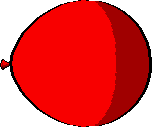 |
Red balloon | A large red balloon that Yoshi can ride for a limited time before it deflates. |
 |
Rolling rock | Tilting stone buttes that fall if stood on too long. |
| Sealed Door | Doors that have been boarded up and can no longer be entered after a certain point. | |
| Shack | Most shacks are locked and contain Mini Battles. Unlocked ones give Yoshi skis. | |
| Ski Lift | Moving seats suspended from rails on the snowy mountains. | |
 |
Snowball | A snowball that becomes larger the more Yoshi pushes it in snow. It can also defeat enemies and can be used as a platform for Yoshi. |
| Soft rock[4] | Weak rocky walls that can be quickly chipped through with nearly any manner of attack. Breakable rock comes in various colors and textures. | |
 |
Spinning doors[5] | A rapidly spinning quartet of doors; Yoshi can pick the one he will go through by hitting it with an egg, causing it to fall and the rest to disappear. |
| Spinning Log | Orange logs that stay still for a while and then start spinning wildly, which can either help or hinder Yoshi. | |
| Spinning wheel | Circular lifts that travel in the direction it is pointing when a Yoshi stands on it. They stop spinning when a Yoshi stands on it, and they continue when a Yoshi jumps off of it. A Yoshi can also eat these and spit them out to another area. If a Yoshi falls off to an area where the Yoshi cannot reach the spinning wheel, it respawns in the location it started at. There are two main types of spinning wheels: the blue spinning wheels disappear if a Yoshi jumps off one and does not ride it again for a while, while the tan ones stay there until Yoshi leaves the room or goes at a far enough distance away from the tan spinning wheel. A rare double-arrowed type only moves up and down or left and right, rotating when hit by an egg. | |
| Spotted platform | Flatbed Ferries with spikes covering one side. | |
| Spring ball | Balls that Yoshi can jump on top of, then jump again to be propelled high into the air with a boosted jump. Yoshi can jump even further up if he times the jump right when the he contacts the spring ball. There are also larger variations, which propel Yoshi even higher. | |
| Squishy block | Jelly-like blocks that move when pushed. When they hit a wall, they squish against the wall, growing taller and thinner. When performing a Pound The Ground on them, the inverse happens. They can be used to safely cross over spikes. | |
| Step | Tiny Semisolid Platforms that appear in chains as bridges or stairs, often summoned by ? Clouds. | |
| Sway bridge | A bridge that wildly rocks along its center towards the screen. | |
| Switch | Switches that cause Dotted Line Blocks to transform into ! Blocks. | |
| Teeter-totter | Long platforms that rotate from Yoshi's weight. Log-based ones fall if tilted far enough. | |
| Track | Rails that various types of platforms travel along. | |
| Tulip | Giant floating red flowers that spit out eight Stars when an egg, shell, or a spit-up enemy enters them. | |
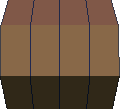 |
Tumbler | Huge industrial nuts that spin when stood upon. |
| Twirling tier[6] | Spinning platforms that can move Yoshi and whose functional length changes depending on how big they look at the time. | |
| Warp Pipe | Pipes that lead to other places. They can sometimes spawn enemies, usually as a source for Yoshi Eggs. | |
| Watermelon jar | Small pots that appear in the Watermelon Seed Spitting Contest to dispense watermelons. | |
| Winged Cloud | Clouds that trigger events when a Yoshi Egg is thrown at them. | |
| Wooden Ferry[citation needed] | Completely inert brown Flatbed Ferries of varying length that act as floating Semisolid Platforms. | |
| Yoshi Block | Blocks that transform Yoshi back to normal after he has been transformed into a vehicle. |
Obstacles
Minigames
Bonus Challenge
Bonus Challenges are initiated when the Goal Ring stops on a flower at the end of the level. Yoshis can increase the chances of playing a Bonus Challenge by collecting Special Flowers on the level. During a Bonus Challenge, the player players one of several minigames. Upon winning the minigame, the player can receive lives or Special Items. A specific Bonus Challenge is unlocked when the player collects 800 points in a world, and that specific Bonus Challenge can be played any time.
There are six Bonus Challenges in total.
| Image | Name | Description
|
|---|---|---|
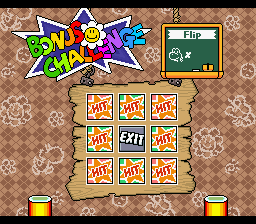 |
Flip Cards | Players flip over panels to earn Special Items and lives, but lose their rewards if Kamek is flipped over. |
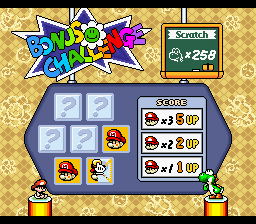 |
Scratch and Match | Players scratch cards with baby Mario icons to earn lives. |
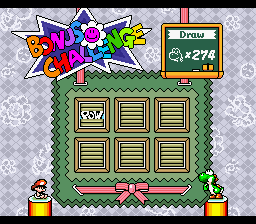 |
Drawing Lots | Players can earn Special Items by selecting a panel that does not contain a Kamek card. |
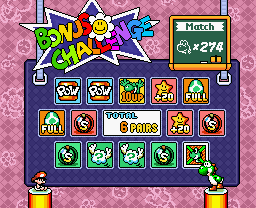 |
Match Cards | Players need to memorize pairs of panels and flip over the correct pairing to receive Special Items or lives. |
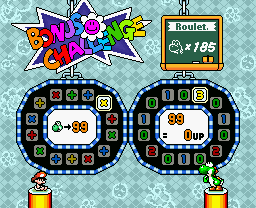 |
Roulette | Players bet lives on a roulette, which randomly spins to generate an equation that increases or decreases lives depending on what was stopped on. |
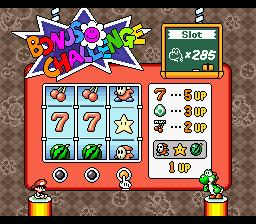 |
Slot Machine | Players stop a slot machine, which generates lives depending on the combo stopped on. |
Mini Battles
Mini Battles are minigames that can be played in various levels, when a Yoshi receives a key and enters a Bonus Game Shack. These are competitive fights against a Bandit, and besting that Bandit earns the Yoshi a reward. Mini Battles can later be played in the main level selection screen after they have been unlocked. If the players hold and press
,
,
,
, and
on the level selection screen, a screen pops up listing all Mini Battles, as well as a 2-player version of Throwing Balloons and Watermelon Seed Spitting Contest and a 4-button Throwing Balloons mode.
There are four Mini Battles in total. Template:Content appearances
Special Items
By winning Bonus Challenges and Mini Battles, the player's prizes can be one of several Special Items. These items can be used at any time during a level (except during boss battles) by going to the pause menu and selecting one of them with . Up to 22 of these items can be carried at a time.
| Image | Name | Description
|
|---|---|---|
| 10 Point Star | Increases the amount of time in the Countdown Timer by ten seconds. | |
| 20 Point Star | Increases the amount of time in the Countdown Timer by twenty seconds. | |
| Anytime Egg | Refills Yoshi Egg count up to six. | |
| Anywhere POW | Creates a shockwave that turns all on-screen enemies into Stars. | |
| Winged Cloud Maker | Transforms all on-screen enemies into Winged Clouds. | |
| Magnifying Glass | Reveals red coins and hidden Winged Clouds to the player. | |
| Super Green Watermelon | Gives Yoshi a green watermelon, allowing him to shoot seeds. | |
| Super Red Watermelon | Gives Yoshi a red watermelon, allowing him to spit fire. | |
| Super Blue Watermelon | Gives Yoshi a blue watermelon, allowing him to breathe frost. |
Soundtrack
- Main article: Super Mario: Yossy Island Original Sound Version
A soundtrack CD was released in Japan on November 25, 1995, titled Super Mario: Yossy Island Original Sound Version. The disc contains 26 music cues from the game's soundtrack, as composed by Koji Kondo.
The instrumentation for this game's music was sampled from the Akai S1000 synthesizer; E-mu Systems' Proteus synthesizers; the Korg 01/W; Optical Media International's Universe of Sounds Vol. 2; Roland's L-CD1 synthesizer, Sound Canvas SC-88 module, and R-8 drum machine; and the Yamaha TG77 and TG100. The Roland Sound Canvas, in particular, would go on to become one of the longest-used sources of instrumentation in Super Mario franchise music, with samples from both the SC-88 and the later SC-8850 model being used in numerous games during the next four gaming generations. Some of the game's sound effects are samples of stock sound effects: the jungle ambience heard on the title screen and baby Mario's cry are taken from Sound Ideas' General Series 6000 library, while Yoshi's tongue sound and the noises made by Piranha Plants come from Rarefaction's A Poke in the Ear with a Sharp Stick.[7]
Promotion
Culver City event
An event was held in front of a Toys "R" Us in Culver City, California on October 5, 1995 at 3:00 PM to promote the North American release of Super Mario World 2: Yoshi's Island. At the event, there was a trailer and a large model Yoshi Egg surrounded by hay. The trailer held a banner with the words "Play It Loud" and stock art of Super Mario World 2: Yoshi's Island. The Yoshi Egg held a banner with the word "Nintendo". The event centered around "hatching" the Yoshi Egg. After the hosts interacted with the idle audience, children were lined up and given small, green hammers which they used to break open a designated area at the bottom of the egg. The Yoshi Egg, when breached, yielded stringed paper and a large model of the game cartridge. Group photos were then taken of children with the cartridge.
The organizers of the event also pledged to donate five hundred dollars to local schools on the condition that the principals of these schools sit on top of the Yoshi Egg for fifteen minutes. A person in a one-piece Mario and Yoshi costume also was seated on top of the Yoshi Egg. Participants could go on and off the egg by means of a forklift.
A raffle was then held with one winner receiving an SNES which included a copy of Super Mario World 2: Yoshi's Island. Other winners may have won t-shirts. Discount coupons were also distributed.
Material
Super Mario World 2: Yoshi's Island was the cover feature of Volume 77 of Nintendo Power. Nintendo Power also distributed eight promotional cards of some of the game's bosses part of their collectible Super Power Club series of cards which began in October 1992 with Volume 44 of Nintendo Power. The front of each card has an in-game image of the character and the reverse had a brief description of the character. The cards include:
- Raphael the Raven
- Roger the Potted Ghost (titled "The Potted Ghost")
- Bigger Boo
- Burt the Bashful (erroneously titled "Bashful Burt")
- Hookbill the Koopa
- Sluggy the Unshaven
- Tap-Tap the Red Nose (titled "Tap Tap the Red Nose")
- Naval Piranha
Videos
Nintendo of America distributed Super Mario World 2: Yoshi's Island: A Magical Tour of Yoshi's Island, a six minute-long promotional VHS. The video featured Ken Lobb and the same person who narrated the Donkey Kong Country: Exposed promotional VHS.
Another promotional video, titled The Invasion of Nintendo, was included with a copy of Nintendo Power and featured Super Mario World 2: Yoshi's Island alongside some other Nintendo games. Ken Lobb made another appearance.
There exists another untitled promotional video that was likely shown on monitors in video game stores. It is about fifty seconds long and consists of clips of the game along with some narration.[8]
Adaptations
Volume 14 of Super Mario-kun mostly focuses on the events of Super Mario World 2: Yoshi's Island, with the arc concluding in volume 15. The Super Mario-kun version of the story features Mario and Luigi traveling back in time to stop adult Bowser and Kamek alongside Yoshi and baby Mario.
A standalone manga, titled "Super Mario: Yossy Island" from the Kodansha Super Mario manga series, was also released. The series, spanning three volumes, was written by Kazuki Motoyama, who had previously written a manga based on the game Yoshi, and published by Kodansha Limited. The first two volumes are based on the stories from the game, while the third volume has original stories that use the game's characters and themes.
Super Mario World 2: Yoshi's Island was also adapted as part of the 4-koma Gag Battle series, also titled "Super Mario: Yossy Island".
An issue from the Game Picture Book series of the Super Mario Ehon series, Super Mario Game Picture Book 4: Hang in There, Yoshi (「スーパーマリオゲームえほん 4 がんばれヨッシー」, Super Mario Game Ehon 4 Ganbare Yoshi), is loosely based off the story of Super Mario World 2: Yoshi's Island.
Yoshi using a red watermelon against Grinders.
A Zeus Guy training baby Mario against a Needlenose, a Cactus Jack, and some Mildes.
Super Mario Game Picture Book 4: Hang in There, Yoshi
Super Mario-kun volume 14.
Baby Mario approaching an Egg-Plant.
Super Mario-kun volume 15. The Helicopter is on the cover along with Powerful Mario (baby Mario).
Baby Mario and baby Luigi's parents
The Super Mario World 2: Yoshi's Island comic from Club Nintendo magazine
Staff
- Main article: List of Super Mario World 2: Yoshi's Island staff
Super Mario World 2: Yoshi's Island was directed by video game designers Takashi Tezuka, Shigefumi Hino, and Hideki Konno and programmer Toshihiko Nakago; the four had worked on previous titles in the Super Mario series, with all except Hino being directors for Super Mario World. Konno had earlier worked as a map and level designer in the previous Super Mario games and served as map director for Super Mario World. This is the first Super Mario-related project to involve Yasuhisa Yamamura, who has most notably worked on the dungeon design in the The Legend of Zelda series. The C.G. design the game employs is credited to Yoshiaki Koizumi, who previously worked on Super Mario Kart as the illustrator. The soundtrack was composed by Koji Kondo, well known for creating the Super Mario franchise's iconic tunes. Shigeru Miyamoto had heavy involvement with the game's development and served as the game's producer, while Nintendo's then-president, Hiroshi Yamauchi, was the executive producer.
Development
In an interview with game journalist Steven Kent, Shigeru Miyamoto stated that he wanted to make a game starring Yoshi as far back as Super Mario World's development.[9] Miyamoto disliked previous Yoshi games (specifically mentioning Yoshi's Cookie, Yoshi's Egg, and Yoshi's Safari, the latter being mistranslated as "Yoshi's World Hunters" in the interview) and wanted to make one more authentic to the Yoshi character.[9]
An early version of the game was demoed to Nintendo's marketing department, who rejected it due to the visuals "lacking punch" in comparison to Donkey Kong Country's pre-rendered 3D graphics.[9] In response, Shigeru Miyamoto developed a more stylized and "cartoony" art direction for the game, which was accepted. Some of the pre-rendered sprites used in the opening of the game are leftovers from the original graphical pitch.
According to Hisashi Nogami, the hand-drawn style was created by literally drawing the characters by hand on paper, scanning them and then carefully copying them to make the sprites "a pixel at a time".[10]
Super Mario World 2: Yoshi's Island was one of three completed games to use the Super FX2 graphics chip, which allowed for larger sprites and more advanced effects such as sprite scaling and rotation (advertised as "Morphmation" technology), basic polygonal rendering, and advanced parallax scrolling.
Reception
Critical reception
Super Mario World 2: Yoshi's Island was critically acclaimed upon release, with most reviews praising the level design, the platforming mechanics, the personality, the graphics, the soundtrack, and the creativity of the game. The game remains critically lauded, garnering a 96.00% on GameRankings based on 5 reviews.[11] The most common criticisms surrounding the game come from baby Mario's crying when he is trapped in a bubble after Yoshi takes a hit from the enemy, often being cited as "annoying". IGN retrospectively said in its article "Is There a Bad Mario Game?", "The game earned instant acclaim and rightfully so for its brilliant stage design and platforming mechanics. Yoshi's Island doesn't beat you over the head with trial and error to teach you how to play, but it also does not hold your hand with a numbingly dull tutorial."[12] Kaes Delgrego of Nintendo Life has referred to the game as "Perhaps the greatest platformer of all time" in his review, giving the game a score of a 10/10.[13] Delgrego called the time-based health mechanic "innovative" for its time and described it as influention on later titles, comparing it to Halo's time-based life mechanic. While he admitted that the game itself isn't revolutionary, Delgrego praised the creativity of its puzzles and pastel-style graphics. Delgrego's only criticisms focused on the easy boss fights and baby Mario's crying when Yoshi takes damage from an enemy. Reece Warrender of Cubed3 gave the game a 9/10,[14] praising the game's new and interesting mechanics, such as swallowing an enemy to create a projectile of it, as well as having simple and enjoyable mechanics that players of any age can enjoy. Warrender praised the quality of the game's graphics and sound while criticizing the easy difficulty and the short length, citing that the game can be completed in five hours despite the replay value of the points system.
Retrospective reviewers often rank Super Mario World 2: Yoshi's Island as one of the greatest video games in the medium's history. Among others, the game was placed 18th in the 100th issue of Nintendo Power's "100 best Nintendo games of all time" in 1997. It also placed 185th in the 200th Issue of Game Informer's "Top 200 Games of All Times", the lowest ranked Super Mario franchise game. Tony Mott listed the game in the 2013 revision of his reference book 1001 Video Games You Must Play Before You Die, making it one of 26 SNES games to be featured, while IGN included Super Mario World 2: Yoshi's Island in the 2003, 2005, 2007, 2015, 2018, 2019, and 2021 lists of the top 100 video games of all time.
| Reviews | |||
|---|---|---|---|
| Release | Reviewer, Publication | Score | Comment |
| SNES | Kaes Delgrego, Nintendo Life | 10/10 | "Yoshi's Island isn't just a great platformer: it's a reminder of why this silly little hobby of ours is so wonderful. Sure, the game contains no political satire, no poetic justice, no character development. But if what Miyamoto and Tezuka crafted isn't a work of art, then the definition of "art" needs to be amended." |
| SNES | NEXT Generation Issue #14 February 1996 | 5/5 | "You'll find yourself baffled at the task of completing this gargantuan game, but you'll definitely enjoy trying." |
| SNES | Reece Warrender, Cubed3 | 9/10 | "Super Mario World was possibly the most popular game to be released on the SNES console. Following a large change of direction in the sequel you will find yourself controlling different Yoshi's in an attempted to protect a baby Mario. The game sounds unappealing, but after giving the game a fair chance you will experience a platformer like no other." |
| SNES | Rob Hamilton, Honest Gamers |
10/10 | "Yoshi's Island may not be perfect, but it provides pure gaming bliss, taking the tried-and-true Super Mario Brothers style of play and adding its own personalized touch. Just stay away from those Fuzzies. The withdrawal is pure agony!" |
| Aggregators | |||
| Compiler | Platform / Score | ||
| Game Rankings | 96.00% | ||
Sales
Super Mario World 2: Yoshi's Island has sold over 4 million copies, with the Edge publication stating that the game was "a radical sequel to Super Mario World whose anarchic gameworld and illustration-style visuals win it loyal fans but less dramatic total sales".[15]
Pre-release and unused content
According to Shigeru Miyamoto, the marketing department at Nintendo wanted him to use pre-rendered 3D sprites like in Donkey Kong Country for the game, rather than stylized 2D sprites. Additionally, found in the game's data are several sprites that go unused, such as several Super Mario All-Stars sprites and three unused Yoshi forms. There are also three unused Mini Battles that can be seen in the game's code.
The game was originally intended to feature the prefix Super Mario Bros. 5, which was shortened to Super Mario in the final Japanese release. A similar concept would be carried over to the international edition, which uses the prefix Super Mario World 2; the original Super Mario World was previously subtitled Super Mario Bros. 4 on the Japanese release.[16] It has sometimes been nicknamed Super Mario Bros 5: Yoshi's Island (or Super Mario Bros 5 for short).[17]
Glitches
- Main article: List of Super Mario World 2: Yoshi's Island glitches
Constantly full mouth
By jumping through a Middle Ring and spitting out an enemy at the same time, Yoshi constantly appears to have a full mouth, despite still being able to stick his tongue out and not being able to spit anything out.[18]
Giant Egg anywhere
By going into any level with a Fat Guy and carrying a Giant Egg to the end of a level, the player must go to the edge of the screen past the exit and throw the egg up, then use Yoshi's tongue to push it slightly into the edge of the screen. By finishing the level like this, the next Yoshi will collect the egg as it appears to take baby Mario, allowing the player to take a Giant Egg into any level in the game.[18]
Remakes and ports
Yoshi's Island: Super Mario Advance 3
- Main article: Yoshi's Island: Super Mario Advance 3
Super Mario World 2: Yoshi's Island was later ported to the handheld Game Boy Advance as part of the Super Mario Advance series, a series of updated remakes of classic Super Mario games, as Yoshi's Island: Super Mario Advance 3. The third entry in the series, it boasted new levels and slightly altered some of the original game's graphics and dialogue, as well as making various other minor changes. This version of the game is the only version available through the Virtual Console on future consoles, rather than the original version.
SNES Classic Edition
Super Mario World 2: Yoshi's Island is one of the 21 titles included on the Super NES Classic Edition. This was the SNES version’s first release since the original run.
Super Nintendo Entertainment System - Nintendo Switch Online
Super Mario World 2: Yoshi's Island, along with Super Mario World and Super Mario Kart, is one of the 20 launch titles for Super Nintendo Entertainment System - Nintendo Switch Online.
Version differences
- TCRF article: Super Mario World 2: Yoshi's Island/Version Differences
Later versions of the Japanese release pluralize the collectables in the score screen and alter the number of dots that connect each term to its respective counter. The line in the Red Coin counter is increased by one dot, while the line in the total score counter is decreased to account for the pluralization of "Total Point."
Regional differences
- This is the first Super Mario game with French and German localizations, and the only SNES Super Mario game to have these. (Super Mario RPG, the lone SNES Super Mario game released later, was not localized for PAL regions, therefore no such translations were written.) Accordingly, the PAL release gives the player the option to select a language at the start of the game.
- The title screen in the Japanese version of the game is rendered in katakana. International versions replace this with a new logo written in English.
- The European release omits the ® symbol from the Super Mario World 2 prefix on the title logo.
- In the map selection screen, the thumbnail tiles for the extra levels in the Japanese versions of the game are a red and orange background. They are also called "Special" stages.
- In the Japanese release, the thumbnails for extra and bonus stages consist of stylized katakana logos; the extra stages all read スペシャル ("Special") and are suffixed by the world number, while the bonus stages each list the name of their respective bonus game. In international releases, the extra stage thumbnails depict a numbered star with "EXTRA" written below, while the bonus stage thumbnails depict a numbered Special Flower with "BONUS" written below.
- The score thumbnail in international versions of the game has a completely different sprite than Japanese versions of the game, depicting a pencil drawing a line rather than a pencil writing "100" on an index card. The SNES controller in the North American version of the game also has its buttons changed to purple, though the control options menu retains the multicolor buttons seen on the Super Famicom and European SNES.
- The thumbnail for the Popping Balloons Mini Battle is slightly tweaked in international versions of the game, rounding the balloon down at the edges of the thumbnail and increasing the size of Yoshi's hands.
- The thumbnail for World 4-6: Lake Shore Paradise has a slightly altered Flopsy Fish in international versions of the game, featuring larger and more angular pectoral fins.
- In the European version, as well as US Revision 1.1, the font is much thicker than in the Japanese version, though graphics such as controller buttons were left the same. This thicker font was later used in all versions of Yoshi's Island : Super Mario Advance 3.
- International versions of the game remove onomatopoeia words from the chalkboard tutorial graphics and the Popping Balloons Mini Battle. Additionally, the symbol that appears when popping the correct balloon in the latter is changed from the kanji 当 ("win") surrounded by stars to a star pattern made of stars.
- In World 6-★: Castles - Masterpiece Set, the pathed-moving platforms in the Japanese version of the game spelled out "YOSSY", Yoshi's alternate romanized Japanese name. International versions change this to "YOSHI".
References to other games
- Mario Bros.: POW Blocks can be hit thrice before they disappear, like in this game.
- Alleyway: Breakable blocks are featured in some levels, and are broken in a similar manner to the ones in the game.
- Super Mario Bros.: The end of the credits features a rearranged version of this game's "end of level" fanfare. Fire Bars return, albeit depicted as swinging three-dimensionally.
- Super Mario Bros. 2: Shy-Guys and Snifits reappear; these enemies also serve as the basis for many of the new enemies in Super Mario World 2: Yoshi's Island. The sub areas attached to enemy-generating Warp Pipes resemble those within Jars. POW Blocks retain their color scheme from this game.
- Super Mario Bros. 3: Chain Chomps, Donut Blocks, and Nipper Plants return. Spikes return as Mace Penguins.
- Super Mario World: The American and European versions of the game are sold as a prequel to Super Mario World. Also, some of Yoshi's sound effects are recycled. Expansion Blocks utilize an unused sound effect from this game when they expand. Big Boos, Beach Koopas, and Fishin' Lakitus return. Flying Wigglers are based on Wigglers. A single Magikoopa returns as Kamek, whose name is derived from the name for the Magikoopa species in Japanese:「カメック」(Kamekku). Gargantua Blarggs and Red Blarggs are named after Blarggs. Piscatory Petes resemble the Cheep Cheep design of Super Mario World, along with the Blurps of the same game. Powerful Mario wears Caped Mario's cape. Dotted-Line Blocks temporarily transform into ! Blocks upon hitting a Switch, like how they could be transformed by the big switches of this game. Lakitu's cloud can be ridden, like in this game.
- Yoshi's Cookie: Yoshi's sprite is based on his sprite from the SNES version of the game, which was also the basis for his sprite in Super Mario All-Stars.
References in later games
- Super Mario RPG: Legend of the Seven Stars: The Magikoopa fought in Bowser's Keep has a thought that strongly implies it is Kamek; while he is clearly familiar with Bowser in the English translation, the Japanese version of the line indicates that he recognizes Mario as the baby.
- Super Mario 64: A part of the "Powerful Infant" theme is reused for the "Powerful Mario" theme in this game.
- Tetris Attack: The game is a reskin of Panel de Pon featuring many of the same creatures as Super Mario World 2: Yoshi's Island. The main theme is also rearranged as the title screen music and is also incorporated into the end credits melody in the Game Boy port.
- Yoshi's Story: This game was originally titled Yoshi's Island 64.
- Mario Kart 64: Yoshi's sound effects were reused in this game.
- Super Smash Bros.: Yoshi's moves and attacks were taken from this game.
- Paper Mario: Raphael the Raven returns, and Lava Piranha has a similar appearance to Naval Piranha. The music for Yoshi's Village is a variation on the title screen music. Additionally, one of Parakarry's attacks is similar to the Targeting system.
- Mario Party 2: For the minigame Tile Driver, the Goomba and Koopa Troopa patterns are modified versions of their respective artwork from this game.
- Super Mario Sunshine: The background of The Beach Cannon's Secret's secret course uses the same art style as Super Mario World 2: Yoshi's Island.
- Mario Party 4: Four Salvo the Slimes are featured as obstacles in Slime Time.
- Nintendo Puzzle Collection: In Yoshi no Cookie, the Action Mode stage backgrounds are based on Super Mario World 2: Yoshi's Island. Additionally, the normal end credits melody of the new Panel de Pon is arranged from the Game Boy port of Tetris Attack, which in turn contains the main theme.
- Mario Party-e: Yoshi and Shy Guy's sprite from Fast Feed Yoshi! are taken from this game.
- Mario Kart: Double Dash!!: The course, Baby Park, takes heavy inspiration from this game, with the track banner and locations employing a similar art style. Baby Mario and Baby Luigi's karts, the Goo-Goo Buggy and the Rattle Buggy have the Special Flower engraved on them.
- Mario & Luigi: Superstar Saga: A cover of Superstar Mario's theme is played during the Star 'Stache Smash minigame in this game. This cover has been removed from the remake.
- Mario Party Advance: Naval Piranha returns, alongside Goonies and other species.
- Super Princess Peach: The game's sprite work is reminiscent to those used in Super Mario World 2: Yoshi's Island, especially with Koopa Paratroopas having long wings. Additionally, the game uses enemies that originated from this game such as Kaboombas and Fangs.
- Mario & Luigi: Partners in Time: The events of this are mentioned by Kamek. An arrangement of this game's alternate title music is used for Yoshi's Island in this game.
- Yoshi Touch & Go: This game is a retelling of Super Mario World 2: Yoshi's Island's events.
- Yoshi's Island DS: This game is the sequel and also takes place on the same titular island, and most of the enemy sprites are from this game, albeit with updated shading. Its events are mentioned at the start of the game.
- Super Mario 64 DS / New Super Mario Bros.: The "Powerful Mario" theme from Super Mario 64 returns. A slightly altered version with different instruments can also be heard in certain minigames such as Balloon Racing and Bounce and Trounce.
- Mario Kart Arcade GP 2: The tracks Yoshi Park 1 and Yoshi Park 2 have amusement park rides that take heavy inspiration from this game.
- Itadaki Street DS: This game features the map of Yoshi's Island.
- Super Mario Galaxy: An orchestral arrangement of Superstar Mario's theme is used as the theme of Rainbow Mario in this game.
- Super Smash Bros. Brawl: The Yoshi's Island stage is inspired from this game. Some tracks of the game's soundtrack are covered in this game, including the Ground Theme and the Athletic Theme.
- New Super Mario Bros. Wii: Kamek reappears and uses his magic to power up the Koopalings. Fake walls reappear. Kamek turns Bowser into a giant for the final battle.
- New Super Mario Bros. U: Kamek again uses magic to enhance boss fights and turn Bowser into a giant.
- Yoshi's New Island: This game continues the story told from Super Mario World 2: Yoshi's Island.
- Super Mario Maker: The Baby Mario Costume uses modified sprites from this game.
- Mini Mario & Friends: amiibo Challenge: The soundtrack of Egg Launch Land is a complete arrangement of "Flower Garden", which plays in Make Eggs, Throw Eggs and other levels.
- Mario Party: Star Rush: A minigame called Dodge Fuzzy, Get Dizzy is a reference to the Touch Fuzzy, Get Dizzy level.
- Super Mario Run: When the player grabs a Super Star in Remix 10, a rearrangement of the Powerful Infant theme can be heard.
- WarioWare Gold: This game contains a microgame based on Super Mario World 2: Yoshi's Island, where Yoshi must save Baby Mario from a bubble.
- Super Smash Bros. Ultimate: Slugger & Green Glove appear as a spirit, using artwork from Super Mario World 2: Yoshi's Island. Bowser's Final Smash in this game is based on Baby Bowser's second boss battle.
- Mario Kart 8 Deluxe: The Yoshi's Island course in the Booster Course Pass is based on the game, with numerous obstacles being based on its enemies and sections based on the island layout and world themes as seen in the 3D overview on the title screen. The music is an arrangement of the athletic theme. Starting a race plays the Game Start theme, and finishing a race plays an arrangement of the Goal & Score theme. Kamek's speaking sound effect is used for his horn.
- Mario Kart Tour: Yoshi's Island returns as a race course in this game. The Smiley Flower Glider's art and animation are derived from the Smiley Flower from this game.
- Super Mario Bros. Wonder: The 1-Up jingle sounds similar to the one from Yoshi's Island. Melon Piranha Plants spit seeds similar to Yoshi and Ukikis with a watermelon, and Yoshis can spit seeds by eating them as well. The Yoshis' animations like running and falling are also similar.
- WarioWare: Move It!: A microgame based on Yoshi's Island appears in this game, in which Yoshi needs to run away from a Chomp Shark.
Media
- For a complete list of media for this subject, see List of Super Mario World 2: Yoshi's Island media.
| File info 0:29 |
| File info 0:49 |
Gallery
- For this subject's image gallery, see Gallery:Super Mario World 2: Yoshi's Island.
Yoshi aiming an egg at a Special Flower
Baby Mario trapped in a bubble
Names in other languages
| Language | Name | Meaning | Notes |
|---|---|---|---|
| Chinese (simplified) | 超级马力欧 耀西岛 (Super Nintendo Entertainment System - Nintendo Switch Online)[19] Chāojí Mǎlì'ōu Yàoxī Dǎo |
Super Mario: Yoshi Island |
References
- ^ Miller, Kent, and Terry Munson. Super Mario World 2: Yoshi's Island Player's Guide. Page 81.
- ^ Miller, Kent, and Terry Munson. Super Mario World 2: Yoshi's Island Player's Guide. Page 34.
- ^ Miller, Kent, and Terry Munson. Super Mario World 2: Yoshi's Island Player's Guide. Page 14.
- ^ Miller, Kent, and Terry Munson. Super Mario World 2: Yoshi's Island Player's Guide. Page 10.
- ^ Miller, Kent, and Terry Munson. Super Mario World 2: Yoshi's Island Player's Guide. Page 116.
- ^ Miller, Kent, and Terry Munson. Super Mario World 2: Yoshi's Island Player's Guide. Page 124.
- ^ https://docs.google.com/spreadsheets/d/1JJBlHHDc65fhZmKUGLrDTLCm6rfUU83-kbuD8Y0zU0o/edit?pli=1#gid=717751203
- ^ https://www.youtube.com/watch?v=WKzA-SCjnG4
- ^ a b c The Ultimate History of Video Games: The Story Behind the Craze that Touched our Lives and Changed the World, p. 518.
- ^ Kotaku, "How Yoshi’s Island Got Its Beautiful, Hand-Drawn Look", 2018-06-15
- ^ GameRankings score. GameRankings. Retrieved March 1, 2018.
- ^ (February 13, 2009) "Is There a Bad Mario Game?" IGN. Retrieved March 1, 2018.
- ^ Delgrego, Kaes. (July 22, 2009). Review: Super Mario World 2: Yoshi's Island Nintendo Life. Retrieved March 1, 2018.
- ^ Warrender, Reece. (March 31, 2006) Super Mario World 2: Yoshi's Island (Super Nintendo) Review Cubed3. Retrieved March 1, 2018.
- ^ Edge Staff (June 25, 2007). THE NINTENDO YEARS. Edge. Retrieved March 1, 2018.
- ^ Brian (July 24, 2020). Nintendo leaks continue with massive release of game protoypes, source code, and more. Nintendo Everything. Retrieved September 16, 2021.
- ^ Nintendo Magazine System (Australia) issue 30, pages 10 and 11.
- ^ a b Super Mario World 2: Yoshi's Island Glitches (SNES) - Son Of A Glitch - Episode 37. A + Start (January 30, 2015). Retrieved February 15, 2015.
- ^ From the game description of Super Nintendo Entertainment System - Nintendo Switch Online
- ^ Mandelin, Clyde (June 8, 2017). Why Yoshi Is Sometimes Called Yossy in Japan. Legends of Localization. Retrieved December 28, 2021.
External links
- Japanese website
- North American website
- Super Mario: Yoshi's Island Japanese Super Famicom Manual
- Super Mario World 2: Yoshi's Island North American SNES manual
| Super Mario World 2: Yoshi's Island / Yoshi's Island: Super Mario Advance 3 | |||
|---|---|---|---|
| Characters | Yoshis • Baby Mario • Baby Luigi • Baby Bowser • Kamek • Stork • Poochy • Huffin Puffin • Liquid lift • Melon Bug • Muddy Buddy • Support Ghost | ||
| Worlds | Welcome To Yoshi's Island • World 1 • World 2 • World 3 • World 4 • World 5 • World 6 | ||
| Items | Regular items | Blue watermelon • Coin • Green Shell • Green watermelon • Key • Red coin • Red Shell • Red watermelon • Special Flower • Star • Super Star • Yoshi's egg (Flashing Egg · Giant Egg · Red Egg · Yellow Egg) | |
| Special Items | 10-Point Star • 20-Point Star • Anytime Egg • Anywhere POW • Magnifying Glass • Super Blue Watermelon • Super Green Watermelon • Super Red Watermelon • Winged Cloud Maker | ||
| Objects | ! Block • Arrow block • Arrow Cloud • Balloon (Mini Battle) • Balloon (platform) • Beanstalk • Breakable block • Bubble • Bucket • Chomp Rock • Coin Block • Cork • Countdown Platform • Cracked block • Current • Donut Lift • Dotted-Line Block • Egg Block • Egg Plant • Expansion Block • Falling stone block • Flatbed Ferry • Flipper • Goal Ring • Ice Block • Icicle • Makeshift surfboard • Message Block • Middle Ring • Morph bubble • Moving block • Paddle wheel • Pinwheel • Post • Pot • POW Block • Red-and-yellow bridge • Red balloon • Rolling rock • Seesaw • Ski Lift • Snowball • Soft rock • Spinning Log • Spinning wheel • Spotted platform • Spring ball • Squishy block • Switch • Teeter-totter • Tulip • Tumbler • Warp Pipe • Winged Cloud • Yoshi Block | ||
| Bosses | Burt the Bashful • Salvo the Slime • Bigger Boo • Roger the Potted Ghost • Froggy • Naval Piranha • Marching Milde • Hookbill the Koopa • Sluggy the Unshaven • Raphael the Raven • Tap-Tap the Red Nose • Baby Bowser • Big Baby Bowser | ||
| Enemy classes | Edibilis Boringus • Harrassimentia Phlyoverus • Projectilia Ritebakatchia • Ucantia Defeatus • Dudim Phreykunoutonthis • Mostosti Vomitonus | ||
| Enemies | Aqua Lakitu • Bandit • Baron von Zeppelin • Barney Bubble • Beach Koopa • Big Boo • Blow Hard • Boo Balloon • Boo Blah • Boo • Boo Guy • Boo Man Bluff • Bouncing Bullet Bill • Bowling Goonie • Bubble Dayzee • Bullet Bill • Bumpty • Burt • Cactus Jack • Caged Ghost • Chain Chomp • Clawdaddy • Cloud Drop • Coin Bandit • Crazee Dayzee • Dancing Spear Guy • Dangling Ghost • Dizzy Dandy • Dr. Freezegood • Eggo-Dil • Fang • Fat Guy • Fishing Lakitu • Flamer Guy • Flightless Goonie • Flightless Skeleton Goonie • Flopsy Fish • Fly Guy • Flying Wiggler • Frog Pirate • Fuzzy • Gargantua Blargg • Georgette Jelly • Goomba • Goonie • Green Glove • Green Toady • Grim Leecher • Grinder • Grunt • Gusty • Harry Hedgehog • Hefty Goonie • Hootie the Blue Fish • Hot Lips • Incoming Chomp • Itsunomanika Heihō • Jean de Fillet • Kaboomba • Kamek • Kamek's Toadies • Koopa Troopa • Lakitu • Lantern Ghost • Lava Bubble • Lava Drop • Little Mouser • Little Skull Mouser • Loch Nestor • Lunge Fish • Mace Guy • Mace Penguin • Milde • Missile Billa • Mock Up • Mufti Guy • Needle • Nep-Enut • Nipper Plant • Nipper Spore • Para-Koopa • Piro Dangle • Piscatory Pete • Pokey • Preying Mantas • Puchipuchi L • Raven • Raven (chick) • Red Blargg • Relay Heihō • Sanbo Flower • Shark Chomp • Shy-Guy • Shy-Guy on Stilts • Skeleton Goonie • Slime • Slime Drop • Slugger • Sluggy • Snifit • Solo Toady • Spear Guy • Spiked Fun Guy • Spooky • Spray Fish • Stretch • Tap-Tap • Tap-Tap the Golden • Thunder Lakitu • Train Bandit • Wall Lakitu • Whirly Fly Guy • Wild Piranha • Wild Ptooie Piranha • Woozy Guy • Zeus Guy | ||
| Obstacles | Ball 'N' Chain • Ball and chain • Cannonball • Fire-Bar • Lava • Spike • Spiked ball • Spiked weight • Thorn • Turtle Cannon | ||
| Mini Battles | Gather Coins • Popping Balloons • Throwing Balloons • Watermelon Seed Spitting Contest | ||
| Bonus Challenges | Flip Cards • Scratch and Match • Drawing Lots • Match Cards • Roulette • Slot Machine | ||
| Music | Athletic BGM • Flower Field BGM | ||
| Miscellaneous | Countdown Timer • Yoshi's Island | ||
| Further info | Gallery (SNES · GBA) • Glitches • Mario Bros.a • Baby Mario's A-Maze-ing Gamea • Media • Nintendo Music • Pre-release and unused content • Staff (SNES · GBA) • Super Mario: Yossy Island Original Sound Version | ||
| Yoshi games | ||
|---|---|---|
| Platformers | Yoshi's Island series | Super Mario World 2: Yoshi's Island (1995, SNES) • Yoshi's Island DS (2006, DS) • Yoshi's New Island (2014, 3DS) |
| Other | Yoshi's Story (1997, N64) • Yoshi Topsy-Turvy (2004, GBA) • Yoshi Touch & Go (2005, DS) • Yoshi's Woolly World (2015, Wii U) • Yoshi's Crafted World (2019, Switch) | |
| Puzzle games | Yoshi (1991, NES) • Yoshi's Cookie (1992, NES) • Tetris Attack (1996, SNES) | |
| Other | Yoshi's Safari (1993, SNES) • Yoshi's Egg Toss (2006, Adobe Flash) | |
| Reissues | Yoshi no Cookie: Kuruppon Oven de Cookie (1994, SNES) • Yoshi's Island: Super Mario Advance 3 (2002, GBA) • Poochy & Yoshi's Woolly World (2017, 3DS) | |
| Play Nintendo Activities | Play | Yoshi's New Island Match-Up (2014) • Crafty Collage Maker (2019) |
| Skill quizzes | Trivia: Are you an expert Yoshi-ologist? (2014) • Yoshi's Woolly World Power Badges Quiz (2015) • Yoshi's Crafted World Trivia Quiz (2019) | |
| Personality quizzes | Fun Yoshi Personality Quiz (2015) • Poochy & Yoshi's Woolly World Fun Personality Quiz (2017) | |
| Tech demos | Yoshi Demo (1999, GBA) • Purple Yoshi tech demo (Unknown, GBA) • Balloon Trip (2004, DS) | |
| Crossovers | Super Smash Bros. series | Super Smash Bros. (1999, N64) • Super Smash Bros. Melee (2001, GCN) • Super Smash Bros. Brawl (2008, Wii) • Super Smash Bros. for Nintendo 3DS (2014, 3DS) • Super Smash Bros. for Wii U (2014, Wii U) • Super Smash Bros. Ultimate (2018, Switch) |
| Other | Picross NP Vol. 2 (SFC, 1999) | |
| Super Mario games | |||
|---|---|---|---|
| Platformers | Super Mario series | Main | Super Mario Bros. (1985, NES) • Super Mario Bros.: The Lost Levels (1986, FDS) • Super Mario Bros. 2 (1988, NES) • Super Mario Bros. 3 (1988, NES) • Super Mario Land (1989, GB) • Super Mario World (1990, SNES) • Super Mario Land 2: 6 Golden Coins (1992, GB) • Super Mario 64 (1996, N64) • Super Mario Sunshine (2002, GCN) • New Super Mario Bros. (2006, DS) • Super Mario Galaxy (2007, Wii) • New Super Mario Bros. Wii (2009, Wii) • Super Mario Galaxy 2 (2010, Wii) • Super Mario 3D Land (2011, 3DS) • New Super Mario Bros. 2 (2012, 3DS) • New Super Mario Bros. U (2012, Wii U) • Super Mario 3D World (2013, Wii U) • Super Mario Maker (2015, Wii U) • Super Mario Run (2016, iOS/iPadOS/Android) • Super Mario Odyssey (2017, Switch) • Super Mario Maker 2 (2019, Switch) • Super Mario Bros. Wonder (2023, Switch) |
| Reissues | VS. Super Mario Bros. (1986, VS) • Super Mario Bros. (1986, G&W) • All Night Nippon: Super Mario Bros. (1986, FDS) • Super Mario Bros. (1989, NGW) • Super Mario Bros. 3 (1990, NGW) • Super Mario World (1991, NGW) • Super Mario All-Stars (1993, SNES) • Super Mario All-Stars + Super Mario World (1994, SNES) • BS Super Mario USA (1996, SNES) • BS Super Mario Collection (1997, SNES) • Super Mario Bros. Deluxe (1999, GBC) • Super Mario Advance (2001, GBA) • Super Mario World: Super Mario Advance 2 (2001, GBA) • Super Mario Advance 4: Super Mario Bros. 3 (2003, GBA) • Classic NES Series (2004–2005, GBA) • Super Mario 64 DS (2004, DS) • Super Mario All-Stars Limited Edition (2010, Wii) • Super Mario Maker for Nintendo 3DS (2016, 3DS) • New Super Mario Bros. U Deluxe (2019, Switch) • Super Mario 3D All-Stars (2020, Switch) • Game & Watch: Super Mario Bros. (2020, G&W) • Super Mario 3D World + Bowser's Fury (2021, Switch) | ||
| Related games | Super Mario Bros. Special (1986, computer) • Wario Land: Super Mario Land 3 (1994, GB) • Super Mario World 2: Yoshi's Island (1995, SNES) • New Super Luigi U (2013, Wii U) • Captain Toad: Treasure Tracker (2014, Wii U) • Super Mario Bros. 35 (2020, Switch) • Bowser's Fury (2021, Switch) | ||
| Canceled games | Super Mario's Wacky Worlds (CD-i) • Mario Takes America (CD-i) • VB Mario Land (VB) • Super Mario 64 2 (N64DD) | ||
| Donkey Kong series | Donkey Kong (1981, arcade) • Donkey Kong (1994, GB) | ||
| Mario vs. Donkey Kong series | Mario vs. Donkey Kong (2004, GBA) • Mario vs. Donkey Kong 2: March of the Minis (2006, DS) • Mario vs. Donkey Kong: Minis March Again! (2009, DSiWare) • Mario vs. Donkey Kong: Mini-Land Mayhem! (2010, DS) • Mario and Donkey Kong: Minis on the Move (2013, 3DS) • Mario vs. Donkey Kong: Tipping Stars (2015, 3DS/Wii U) • Mini Mario & Friends: amiibo Challenge (2016, 3DS/Wii U) | ||
| Mario Bros. series | Mario Bros. (1983, arcade) • Mario Bros. Special (1984, computer) • Punch Ball Mario Bros. (1984, computer) • Mario Clash (1995, VB) | ||
| Wrecking Crew series | VS. Wrecking Crew (1984, VS) • Wrecking Crew (1985, NES) • Wrecking Crew '98 (1998, SFC) | ||
| Other | Mario Bros. (1983, G&W) • Mario's Cement Factory (1983, G&W) • Mario & Wario (1993, SNES) • Hotel Mario (1994, CD-i) • Super Princess Peach (2005, DS) • Princess Peach: Showtime! (2024, Switch) | ||
| Reissues | Crazy Kong (1981, arcade) • Donkey Kong (1982, G&W) • Donkey Kong (1982, tabletop) • Mario Bros. Returns (1988, FDS) • Donkey Kong (1994, NGW) • Yoshi's Island: Super Mario Advance 3 (2002, GBA) • Donkey Kong, Donkey Kong Junior, Mario Bros. (2004, arcade) • Virtual Console (2006–2016, Wii/3DS/Wii U) • Captain Toad: Treasure Tracker (2018, Switch/3DS) • Mario vs. Donkey Kong (2024, Switch) | ||
| Tech demos | Super Mario 128 (2000, GCN) • New Super Mario Bros. Mii (2011, Wii U) | ||
| Mario Kart series | Main | Super Mario Kart (1992, SNES) • Mario Kart 64 (1996, N64) • Mario Kart: Super Circuit (2001, GBA) • Mario Kart: Double Dash!! (2003, GCN) • Mario Kart DS (2005, DS) • Mario Kart Wii (2008, Wii) • Mario Kart 7 (2011, 3DS) • Mario Kart 8 (2014, Wii U) • Mario Kart Tour (2019, iOS/iPadOS/Android) • Mario Kart (Switch 2) | |
| Arcade | Mario Kart Arcade GP (2005, arcade) • Mario Kart Arcade GP 2 (2007, arcade) • Mario Kart Arcade GP DX (2013, arcade) • Mario Kart Arcade GP VR (2017, arcade) | ||
| Other | Mario Kart Live: Home Circuit (2020, Switch) | ||
| Ports | Mario Kart 8 Deluxe (2017, Switch) | ||
| Mario Party series | Main | Mario Party (1998, N64) • Mario Party 2 (1999, N64) • Mario Party 3 (2000, N64) • Mario Party 4 (2002, GCN) • Mario Party 5 (2003, GCN) • Mario Party 6 (2004, GCN) • Mario Party 7 (2005, GCN) • Mario Party 8 (2007, Wii) • Mario Party 9 (2012, Wii) • Mario Party 10 (2015, Wii U) • Super Mario Party (2018, Switch) • Mario Party Superstars (2021, Switch) • Super Mario Party Jamboree (2024, Switch) | |
| Handheld | Mario Party Advance (2005, GBA) • Mario Party DS (2007, DS) • Mario Party: Island Tour (2013, 3DS) • Mario Party: Star Rush (2016, 3DS) • Mario Party: The Top 100 (2017, 3DS) | ||
| Arcade | Super Mario Fushigi no Korokoro Party (2004, arcade) • Super Mario Fushigi no Korokoro Party 2 (2005, arcade) • Mario Party Fushigi no Korokoro Catcher (2009, arcade) • Mario Party Kurukuru Carnival (2012, arcade) • Mario Party Fushigi no Korokoro Catcher 2 (2013, arcade) • Mario Party Challenge World (2016, arcade) | ||
| Other | Mario Party 4 (2002, Adobe Flash) • Mario Party-e (2003, GBA) | ||
| Sports games | Mario Golf series | Golf (1984, NES) • Stroke & Match Golf (1984, VS. System) • Golf: Japan Course (1987, FDS) • Golf: U.S. Course (1987, FDS) • Golf (1989, GB) • NES Open Tournament Golf (1991, NES) • Mario Golf (1999, N64) • Mario Golf (1999, GBC) • Mobile Golf (2001, GBC) • Mario Golf: Toadstool Tour (2003, GCN) • Mario Golf: Advance Tour (2004, GBA) • Mario Golf: World Tour (2014, 3DS) • Mario Golf: Super Rush (2021, Switch) | |
| Mario Tennis series | Mario's Tennis (1995, VB) • Mario Tennis (2000, N64) • Mario Tennis (2000, GBC) • Mario Power Tennis (2004, GCN) • Mario Tennis: Power Tour (2005, GBA) (Bicep Pump [Unknown, Adobe Flash] • Reflex Rally [Unknown, Adobe Flash]) • Mario Tennis Open (2012, 3DS) • Mario Tennis: Ultra Smash (2015, Wii U) • Mario Tennis Aces (2018, Switch) | ||
| Super Mario Stadium series | Mario Superstar Baseball (2005, GCN) • Mario Super Sluggers (2008, Wii) | ||
| Mario Strikers series | Super Mario Strikers (2005, GCN) • Mario Strikers Charged (2007, Wii) • Mario Strikers: Battle League (2022, Switch) | ||
| Famicom Grand Prix series | Famicom Grand Prix: F1 Race (1987, FDS) • Famicom Grand Prix II: 3D Hot Rally (1988, FDS) | ||
| Other | Donkey Kong Hockey (1984, G&W) • Baseball (1989, GB) • Super Mario Race (1992, GwB) • Easy Racer (1996, SNES) • Mario Hoops 3-on-3 (2006, DS) • Mario Sports Mix (2010, Wii) • Mario Sports Superstars (2017, 3DS) • LEGO Super Mario Goal (2024, Sky Italia) | ||
| Canceled games | Super Mario Spikers (Wii) | ||
| Role-playing games | Paper Mario series | Paper Mario (2000, N64) • Paper Mario: The Thousand-Year Door (2004, GCN) • Super Paper Mario (2007, Wii) • Paper Mario: Sticker Star (2012, 3DS) • Paper Mario: Color Splash (2016, Wii U) • Paper Mario: The Origami King (2020, Switch) | |
| Mario & Luigi series | Mario & Luigi: Superstar Saga (2003, GBA) • Mario & Luigi: Partners in Time (2005, DS) • Mario & Luigi: Bowser's Inside Story (2009, DS) • Mario & Luigi: Dream Team (2013, 3DS) • Mario & Luigi: Paper Jam (2015, 3DS) • Mario & Luigi: Brothership (2024, Switch) | ||
| Other | Super Mario RPG: Legend of the Seven Stars (1996, SNES) | ||
| Remakes | Mario & Luigi: Superstar Saga + Bowser's Minions (2017, 3DS) • Mario & Luigi: Bowser's Inside Story + Bowser Jr.'s Journey (2018, 3DS) • Super Mario RPG (2023, Switch) • Paper Mario: The Thousand-Year Door (2024, Switch) | ||
| Dr. Mario series | Main | Dr. Mario (1990, NES/GB) • Dr. Mario 64 (2001, N64) • Dr. Mario Online Rx (2008, WiiWare) • Dr. Mario Express (2008, DSiWare) • Dr. Luigi (2013, Wii U) • Dr. Mario: Miracle Cure (2015, 3DS) • Dr. Mario World (2019, iOS/iPadOS/Android) | |
| Other | Dr. Mario (1993, GwB) | ||
| Remakes | Tetris & Dr. Mario (1994, SNES) • Nintendo Puzzle Collection (2003, GCN) • Dr. Mario & Puzzle League (2005, GBA) | ||
| Luigi's Mansion series | Main | Luigi's Mansion (2001, GCN) • Luigi's Mansion: Dark Moon (2013, 3DS) • Luigi's Mansion 3 (2019, Switch) | |
| Arcade | Luigi's Mansion Arcade (2015, arcade) | ||
| Remakes | Luigi's Mansion (2018, 3DS) • Luigi's Mansion 2 HD (2024, Switch) | ||
| Educational games | Mario Discovery Series | Mario is Missing! (1992, MS-DOS) • Mario is Missing! (1993, SNES) • Mario is Missing! (1993, NES) • Mario's Time Machine (1993, MS-DOS) • Mario's Time Machine (1993, SNES) • Mario's Time Machine (1994, NES) • Mario's Early Years! Fun with Letters (1993, MS-DOS/SNES) • Mario's Early Years! Fun with Numbers (1994, MS-DOS/SNES) • Mario's Early Years! Preschool Fun (1994, MS-DOS/SNES) | |
| Mario Teaches Typing series | Mario Teaches Typing (1991, MS-DOS) • Mario Teaches Typing 2 (1996, MS-DOS) | ||
| Other | Family BASIC (1984, FC) • Super Mario Bros. & Friends: When I Grow Up (1991, MS-DOS) | ||
| Ports | Mario's Early Years! CD-ROM Collection (1995, MS-DOS) | ||
| Art utilities | Mario Artist series | Mario Artist: Paint Studio (1999, N64DD) • Mario Artist: Talent Studio (2000, N64DD) • Mario Artist: Communication Kit (2000, N64DD) • Mario Artist: Polygon Studio (2000, N64DD) | |
| Other | I am a teacher: Super Mario Sweater (1986, FDS) • Super Mario Bros. Print World (1991, MS-DOS) • Mario Paint (1992, SNES) • Super Mario Collection Screen Saver (1997, PC) • Mario no Photopi (1998, N64) • Mario Family (2001, GBC) | ||
| Miscellaneous | Picross series | Mario's Picross (1995, GB) • Mario's Super Picross (1995, SFC) • Picross 2 (1996, GB) • Picross NP Vol. 6 (2000, SFC) | |
| LCD handhelds | Mario's Bombs Away (1983, G&W) • Mario's Egg Catch (1990, SMBW) • Luigi's Hammer Toss (1990, SMBW) • Princess Toadstool's Castle Run (1990, SMBW) • Mario the Juggler (1991, G&W) | ||
| Pinball | Pinball (1984, NES) • Super Mario Bros. (1992, arcade) • Super Mario Bros. Mushroom World (1992, arcade) • Mario Pinball Land (2004, GBA) | ||
| Arcade | Mario Roulette (1991, arcade) • Piccadilly Circus: Super Mario Bros. 3 (1991, arcade) • Mario World (1991, arcade) • Terebi Denwa: Super Mario World (1992, arcade) • Super Mario World Popcorn (1992, arcade) • Pika Pika Mario (1992, arcade) • Janken Fukubiki: Super Mario World (1992, arcade) • Koopa Taiji (1993, arcade) • Būbū Mario (1993, arcade) • Mario Undōkai (1993, arcade) • Super Mario World (1993, arcade) • Super Mario Kart: Doki Doki Race (1994, arcade) • Mario Bowl (1995, arcade) • Super Mario Attack (1996, arcade) • Super Donkey Kong 2 Swanky no Bonus Slot (1996, arcade) • Donkey Kong (1996, arcade) • Mario Kart 64 (1996, arcade) • Super Mario 64 (1997, arcade) • Super Mario Bros. 3 (Unknown, arcade) • Super Mario World (Unknown, arcade) • Guru Guru Mario (Unknown, arcade) • Dokidoki Mario Chance! (2003, arcade) • Super Mario Fushigi no Janjan Land (2003, arcade) • New Super Mario Bros. Wii Coin World (2011, arcade) | ||
| Browser | Mario Net Quest (1997, Adobe Shockwave) • Mario's Memory Madness (1998, Adobe Shockwave) • Crazy Counting (1999, Adobe Shockwave) • Dinky Rinky (1999, Adobe Shockwave) • Goodness Rakes (1999, Adobe Shockwave) • Melon Mayhem (1999, Adobe Shockwave) • Nomiss (1999, Adobe Shockwave) • Wario's Whack Attack (1998, Adobe Shockwave) • The Lab (The Bookshelf • The Drafting Table • PolterCue • Ask Madame Clairvoya) (2001, Adobe Flash) • Mario Trivia (Unknown, Adobe Flash) • Mario Memory (Unknown, Adobe Flash) • Virus Attack! (Unknown, Adobe Flash) • Mini-Mario Factory Game! (2004, Adobe Flash) • Bill Bounce (2004, Adobe Flash) • Mario Party 7 Bon Voyage Quiz (2005, Adobe Flash) • Super Mario Strikers (2005, Adobe Flash) • Dr. Mario Vitamin Toss (2005, Adobe Flash) • Bowser's Lair Hockey (2005, Adobe Flash) • Heads-Up (2005, Adobe Flash) • Parasol Fall (2005, Adobe Flash) • Dribble Skillz (2006, Adobe Flash) • Superstar Shootout (2006, Adobe Flash) • Cannon Kaos (2006, Adobe Flash) • 1-Up Hunt! (2006, Adobe Flash) • Super Paper Mario Memory Match (2007, Adobe Flash) • Are You Smarter Than Mario? (2008, Adobe Flash) • Play Nintendo activities (2014–present) | ||
| DSiWare applications | Mario Calculator (2009, DSiWare) • Mario Clock (2009, DSiWare) • Nintendo DSi Metronome (2010, DSiWare) | ||
| Other games | Alleyway (1989, GB) • Yoshi's Safari (1993, SNES) • UNDAKE30 Same Game (1995, SFC) • Mario's Game Gallery (1995, MS-DOS) • Mario's FUNdamentals (1998, Windows) • Yakuman DS (2005, DS) | ||
| Tech demos | NDDEMO (2001, GCN) • Mario's Face (Unknown, DS) | ||
| Crossovers | Game & Watch Gallery series | Game & Watch Gallery (1997, GB) • Game & Watch Gallery 2 (1997, GB) • Game & Watch Gallery 3 (1999, GBC) • Game & Watch Gallery 4 (2002, GBA) | |
| Super Smash Bros. series | Super Smash Bros. (1999, N64) • Super Smash Bros. Melee (2001, GCN) • Super Smash Bros. Brawl (2008, Wii) • Super Smash Bros. for Nintendo 3DS (2014, 3DS) • Super Smash Bros. for Wii U (2014, Wii U) • Super Smash Bros. Ultimate (2018, Switch) | ||
| Itadaki Street series | Itadaki Street DS (2007, DS) • Fortune Street (2011, Wii) | ||
| Mario & Sonic series | Mario & Sonic at the Olympic Games (2007, Wii) • Mario & Sonic at the Olympic Games (2008, DS) • Mario & Sonic at the Olympic Winter Games (2009, Wii) • Mario & Sonic at the Olympic Winter Games (2009, DS) • Mario & Sonic at the London 2012 Olympic Games (2011, Wii) • Mario & Sonic at the London 2012 Olympic Games (2012, 3DS) • Mario & Sonic at the Sochi 2014 Olympic Winter Games (2013, Wii U) • Mario & Sonic at the Rio 2016 Olympic Games (2016, Wii U) • Mario & Sonic at the Rio 2016 Olympic Games (2016, 3DS) • Mario & Sonic at the Rio 2016 Olympic Games Arcade Edition (2016, arcade) • Mario & Sonic at the Olympic Games Tokyo 2020 (2019, Switch) • Mario & Sonic at the Olympic Games Tokyo 2020 - Arcade Edition (2020, arcade) | ||
| NES Remix series | Main | NES Remix (2013, Wii U) • NES Remix 2 (2014, Wii U) | |
| Reissues | NES Remix Pack (2014, Wii U) • Ultimate NES Remix (2014, 3DS) | ||
| Mario + Rabbids series | Mario + Rabbids Kingdom Battle (2017, Switch) • Mario + Rabbids Sparks of Hope (2022, Switch) | ||
| Other | Excitebike: Bun Bun Mario Battle (1997, SNES) • NBA Street V3 (2005, GCN) • Dance Dance Revolution: Mario Mix (2005, GCN) • SSX on Tour (2005, GCN) • Tetris DS (2006, DS) • Captain Rainbow (2008, Wii) • Art Style: PiCTOBiTS (2009, DSiWare) • Nintendo Land (2012, Wii U) • Puzzle & Dragons: Super Mario Bros. Edition (2015, 3DS) • Nintendo World Championships: NES Edition (2024, Switch) | ||
| Super Famicom / Super Nintendo Entertainment System games | |
|---|---|
| Super Mario franchise | Super Mario World (1990) • Mario Paint (1992) • Super Mario Kart (1992) • Mario is Missing! (1993) • Super Mario All-Stars (1993) • Yoshi's Safari (1993) • Mario & Wario† (1993) • Mario's Time Machine* (1993) • Mario's Early Years! Fun with Numbers* (1994) • Mario's Early Years! Fun with Letters (1994) • Mario's Early Years! Preschool Fun* (1994) • Tetris & Dr. Mario* (1994) • Super Mario All-Stars + Super Mario World* (1994) • UNDAKE30 Same Game (1995) • Mario's Super Picross† (1995) • Super Mario RPG: Legend of the Seven Stars (1996) • Dr. Mario (1997) • Wrecking Crew '98† (1998) |
| Donkey Kong franchise | Donkey Kong Country (1994) • Donkey Kong Country Competition Cartridge* (1994) • Donkey Kong Country 2: Diddy's Kong Quest (1995) • Donkey Kong Country 3: Dixie Kong's Double Trouble! (1996) |
| Yoshi franchise | Yoshi's Cookie (1993) • Yoshi no Cookie: Kuruppon Oven de Cookie† (1994) • Super Mario World 2: Yoshi's Island (1995) • Tetris Attack (1996) |
| Wario franchise | Mario & Wario† (1993) • Wario's Woods (1994) |
| Satellaview | Wario no Mori Bakushō Version‡ (1995) • Wario no Mori Futatabi‡ (1995) • Easy Racer‡ (1996) • BS Super Mario USA‡ (1996) • Yoshi no Panepon‡ (1996) • Excitebike: Bun Bun Mario Battle‡ (1997) • BS Super Mario Collection‡ (1997–1998) • Satella-Q‡ (1995–1999) |
| Miscellaneous | Nintendo Campus Challenge (1992) • Nintendo PowerFest '94* (1994) • Picross NP^ (1999–2000) |
